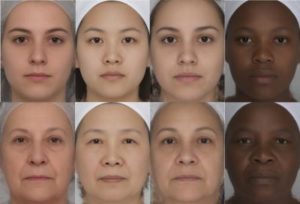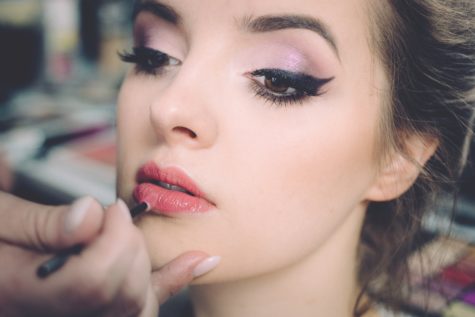LAUSANNE, Switzerland — There may be many reasons for a woman to bat her eyes or pout her lips. But one plausibility is that she instinctively knows that this makes her look younger and more attractive. Such is the finding of a recent study that shows women appear more youthful when their eyes, eyebrows, and lips stand out.
We have been told that the best way to combat aging is to slather on anti-wrinkle creams. But that is only part of the story.
There is another common factor to aging faces, and it is something we pick up on subconsciously. The good news is that a little eye- and lip-enhancing makeup goes a long way toward erasing the years.

Women appear younger depending on how much their features stand out, what researchers call “facial contrast.” And this age perception holds true across all cultures, according to a study conducted by a team of French and American researchers.
“Facial contrast refers to how much the eyes, lips and eyebrows stand out in the face in terms of how light or dark they are or how colorful they are,” says Aurélie Porcheron, one of the study authors, in a media release.
Although wrinkles are the main culprit discussed in the aging process, aging is also a matter of fading facial features. Researchers say our eyes, eyebrows and lips become less prominent as we age. This study shows that cross-culturally women who have more facial contrast are perceived to be younger. This impression holds true no matter the ethnicity of the women being observed or the viewer.
Previous studies have demonstrated that people tend to relate facial contrast with health, youthfulness and femininity. But those studies mostly zeroed in on Caucasian faces viewed by Caucasians. Researchers wanted to study how we see other faces we encounter globally across racial and ethnic lines.
The team of researchers gathered images of four groups of women: Chinese Asian, Latin American, South African and French Caucasian. They chose to focus just on images of women to eliminate gender variations. Researchers used computer software to measure the degree of facial contrast in images of women ranging in age from 20 to 80 years old.
The authors observed some consistent patterns in the aging process. In all four groups of women, facial contrast decreased over time, specifically around the mouth and eyebrows. Researchers say their results show that a natural decline in facial contrast is a common element in the aging process for all women worldwide.
They next tested whether observers from different cultures would pick up on these changes in women across different ethnic groups. They started with photos of women of various ages from the same four ethnic groups, then used computer software to tweak the photos. For each face there was one image with high contrast and one image with low contrast.
Participants for this part of the study included men and women from both France and China. Researchers wanted to test not only images from different cultures but also observers from different cultural backgrounds. They asked the participants to choose which of the two versions of each face looked younger. Nearly 80% of the time, participants chose the high-contrast face. It did not matter which culture the woman’s image represented or the culture of the participant.
“People of different cultures use facial contrast as a cue for perceiving age from the face, even though they are not consciously aware of it,” says Porcheron. “The results also suggest that people could actively modify how old they look, by altering how much their facial features stand out, for example by darkening or coloring their features.”
It turns out that the fountain of youth does not necessarily occupy jars of anti-wrinkle cream. Keeping a youthful appearance might be as easy as the twirl of a mascara wand, the swoosh of eyeliner and the selection of a darker lip shade.
The study appears in the open access journal Frontiers in Psychology.
You might also be interested in:
- Best Mascaras
- Best Eyeliners
- Best Eyelash Curlers
- Best Lip Balms
- Best Makeup Removers
- Best Nail Polish
- Best Ways to Paint Nails
- Best Way to Paint Toenails
